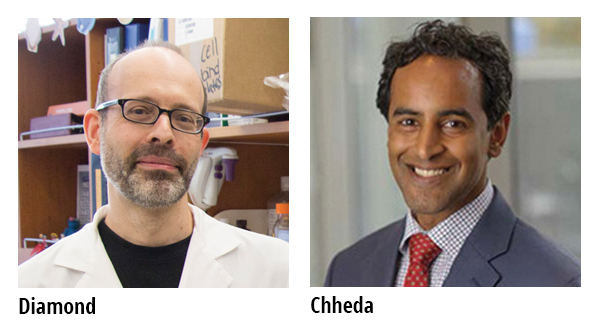Zika virus kills glioblastoma stem cells in early research
From WashU’s Outlook Magazine…
While Zika virus causes devastating damage to the brains of developing fetuses, it one day may be an effective treatment for glioblastoma, a deadly form of brain cancer. New research from Washington University School of Medicine and the University of California San Diego School of Medicine shows that the virus kills brain cancer stem cells, the kind of cells that are most resistant to standard treatments.
“We showed that Zika virus can kill the kind of glioblastoma cells that tend to be resistant to current treatments and lead to death,” said Michael S. Diamond, MD, PhD, the Herbert S. Gasser Professor of Medicine at Washington University and the study’s co-senior author.
The findings are published Sept. 5 in The Journal of Experimental Medicine.
The standard glioblastoma treatment is aggressive — surgery, chemotherapy and radiation — yet most tumors recur within six months. A small population of glioblastoma stem cells often survives the onslaught and continues to divide, producing new tumor cells to replace the ones killed by the cancer drugs.
In their neurological origins and near-limitless ability to create cells, glioblastoma stem cells reminded postdoctoral researcher Zhe Zhu, PhD, of neuroprogenitor cells, which generate cells for the growing brain. Zika virus specifically targets and kills neuroprogenitor cells.
Collaborating with co-senior authors Diamond and Milan G. Chheda, MD, of Washington University, and Jeremy N. Rich, MD, of UC San Diego, Zhu tested whether the virus could kill stem cells in glioblastomas removed from patients at diagnosis. They infected tumors with one of two strains of Zika virus. Both strains spread through the tumors, killing the cancer stem cells while largely avoiding other tumor cells.

Q&A with with Mike Diamond and Milan Chheda

How did you come up with the idea of using Zika to treat glioblastoma?
Diamond: It was really the idea of Zhe Zhu, who was a postdoc with Jeremy Rich. He emailed me several times and said he wanted to do it. I said, “That’s crazy, I don’t want to do that.” Because I knew that a related virus — West Nile — had been tried 50 years ago and it made things worse. It caused serious brain infections and did not cure the cancer. So I said, “That’s not going to work. That’s not safe.” But he kept on asking until I agreed to let him try. Jeremy sent him over to my lab for what was supposed to be three months and turned into a year. And at some point we gathered enough data to look at which cells were being infected and found that it was not replicating throughout the brain and then I no longer had reservations. After we had established that the virus could specifically infect the stem cells, we needed someone with neuro-oncologic expertise. Milan took on a major role at that point.
What has been the response to the study?
Chheda: We’ve received emails from patients all over the world. They say that their loved ones or a friend or they themselves are in this dire situation and ask if they can try Zika. We tell them that it’s not FDA-approved, it hasn’t been proven safe or effective, but some people say they understand that and they want to try it anyway. We’ve been asked if we can bring the virus to some other place, like Mexico, where FDA rules don’t apply so they can try it. And of course we can’t do that, but it just goes to show how desperate people are for any bit of hope.
